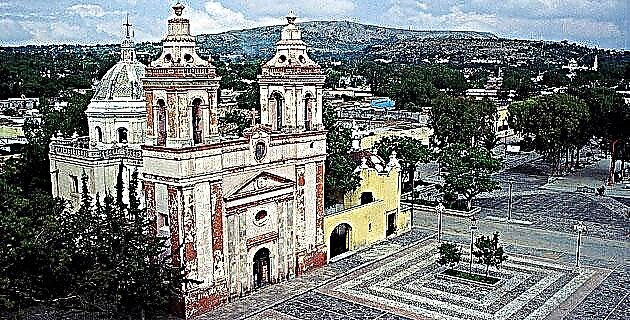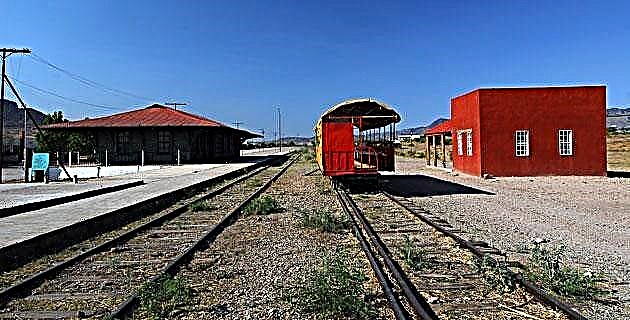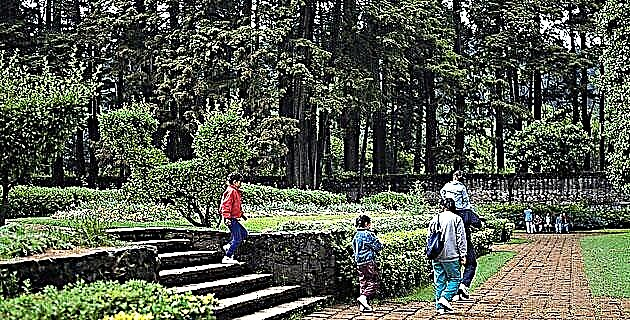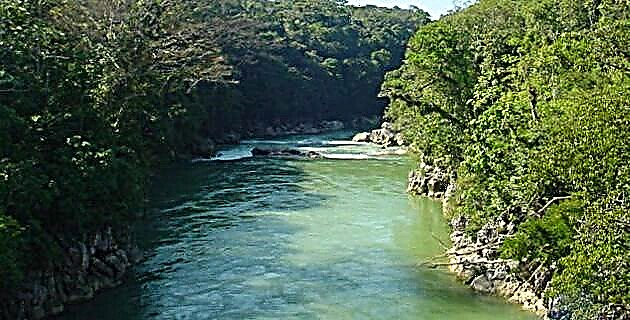
Several indigenous Tzeltal communities inhabit the banks of this mighty river with turquoise blue waters, a product of the calcareous minerals dissolved in them. That's where our story happens ...
ur trip focused on three of these communities that shine for their natural and cultural wealth: San Jerónimo Tulijá, San Marcos and Joltulijá. They were founded by Tzeltals from Bachajón, Chilón, Yajalón and other places, who in the search for land to cultivate, raise their animals and settle with their families, found the ideal place to live on the river bank. It could be said that the three are young populations, since they were founded from 1948, but not the cultural history of its people that goes back to ancient times.
San Jerónimo Tulijá, where the water sings
Until just three years ago, reaching this area from Palenque took approximately two hours, as the road that in theory was supposed to connect the communities of the jungle with the Southern Border Highway, in the middle of a curve, became a tortuous dirt road. Currently the journey has been reduced to one hour thanks to the fact that the road has been paved and there are only a few kilometers of gap from the turnoff at Crucero Piñal to San Jerónimo.
It is saddening to see that what was once wild jungle, today has been turned into pastures. One only recovers when he sees that the communities still conserve, crowning their villages, mountains that explode with life. Refuges that have remained jungle, perhaps because of their sacred nature as living mountains, because of the difficulty of their farming, or because of a combination of both. These mountains are home to thousands of animal species such as the sarahuato monkey, the jaguar, the fearsome Nauyaca snake, and the tepezcuincle, which people usually hunt for food. There are also giant trees such as chicle, ceiba, mahogany and ant, the latter tree from which marimbas are made. The Tzeltals go to the mountains to hunt and collect wild vegetables such as chapay, the fruit of a prickly palm that, along with tortillas, beans, rice, coffee and chicken eggs, form the basis of their diet.
Arrival to San Jerónimo ...
We arrived at night when the great nocturnal symphony, always new and unfinished, was already advanced. Thousands of chirping crickets create a melody that advances in unpredictable waves. Behind the toads are heard, they like stubborn bass, sing with a deep voice and lethargic rhythm. Suddenly, like a possessed soloist, the powerful roar of the sarahuato is heard.
San Jerónimo is a community with places of impressive natural beauty that invite you to contemplate tirelessly while listening to the relaxing song of the water. Just 200 meters from the main square are the Tulijá waterfalls. To reach them, you must cross a small lagoon that serves, now that the heat is pressing, as a meeting point for people of all ages. The tatiketic (older men in the community) come to bathe after their work in the fields; Children and young people also arrive who are completely unaware of the restrictions of those who live in the city and who have to stay at home; women go to wash clothes; and everyone lives together enjoying the freshness of the water. In the middle of spring, when the river is at a low level, it is possible to cross the barrier of semi-aquatic trees, improvised trampolines for young people, and descend through the beautiful blue and white waterfalls.
Bethany Falls
Approximately one kilometer from San Jerónimo, crossing numerous paddocks full of ticks that once in our body strive to fit in places where the sun rarely hits us, there are these waterfalls. They are a sample of what those of Agua Azul must have been - several kilometers downstream - before the tourist invasion. Here the blue waters of the Tulijá River merge with the cold waters of a stream known as K'ank'anjá (yellow river), whose golden color is obtained from the mosses that are born on the white rocks at the bottom, which when in contact with the incandescence of the sun turn a deep amber. In this paradise, where tranquility reigns, couples of toucans can still be seen brandishing their screaming and heavy beaks in the air, while swimming in the deep pools where the water rests before its irremediable fall.
Natural Bridge
It is another site that cannot be missed in these directions. Here the power of Tulijá made its way through a mountain, from whose top you can see on one side the river that attacks its walls to enter it, and on the other, the water that with apparent tranquility flows from a cave following its course . To get to the cavern we descended the steep slope of the hill, and after a revitalizing dive, we dedicated ourselves to admiring the place. The view from below is as enigmatic as it is from above, because one cannot conceive how a tunnel was formed through such a mass of rocks and brush.
Back in San Jerónimo, a succulent plate of tender beans with chapay, accompanied by freshly made tortillas, awaited us at Nantik Margarita's house. The nantik (a term that means “everyone's mother”, given to women for their age and merits by the community) is a good and smiling woman, as well as strong and intelligent, who kindly accommodated us in her home.
San Marcos
If we take this micro region of three communities as if they inhabited the body of the river, San Marcos would be at their feet. To get there we take the same dirt road that leads to San Jerónimo from Crucero Piñal heading north, and just 12 kilometers away we come across the community. It is a much smaller ranchería than San Jerónimo, perhaps for this reason the character and atmosphere of the place is perceived more integrated into the surrounding nature.
The houses have flowery hedge fences in front of their front yards where pets can sneak out. Man's best friends are chickens, turkeys and pigs, which roam freely in the streets and houses.
In the company of our tireless guides and friends, Andrés and Sergio, we went to discover its secrets starting with its waterfalls. In this part its flow increases considerably until it reaches more than 30 meters wide, which complicates access to the waterfalls. To get to this point we had to cross it and on some occasions it was close to dragging more than one, but the spectacle that awaited us was well worth the trouble.
In front of a colossal rock formation carefully carved by the water, simulating the square outlines of a Mayan pyramid devoured by the mountain, is the largest waterfall in the region. It rushes down with force from the heights and creates a mantra that made our dip in the pools preceding the waterfall, a renewing experience to undertake the difficult return across the river.
To end our visit to San Marcos, we go to where its spring is born. The short journey from the community is through the bed of a stream lined with river snails known as puy, which people usually cook with leaves. Sheltered by gigantic organic domes that provide a humid shade, adorned by flowers such as orchids, bromeliads, and other plants that display very long aerial roots that go from the heights to the ground, we arrive at the place where the water springs. Right there is the tallest tree we saw, a huge ceiba of approximately 45 meters, which not only commands respect for its colossal size, but also for the pointed conical thorns on its trunk.
Joltulijá, the origin
Joltulijá (head of the river of rabbits) is where the source of life that maintains the essence of the Tzeltal populations that we visit is born: the Tulijá river. It is about 12 kilometers south of Crucero Piñal, and like San Marcos, it is a small town that has managed to preserve its balance with nature. Its central square is adorned by three monuments to nature, some ceiba trees that offer their cool shade to the visitor.
In order to have free access to the community, it is necessary to go to the authorities, the main tatiketik, to request permission. With the help of Andrés, who worked as our translator since people speak little Spanish, we went with Tatik Manuel Gómez, one of the founders, who cordially granted us permission, invited us to accompany him while he worked and told us about the occasion in that he was apprehended by the traditional authorities for producing posh (cane liquor), receiving as a punishment remaining tied for a whole day to the top of a tree.
From the center of the community, the place where the river is born is about a kilometer away, crossing several cornfields and plots in the fertile lands of the shore. Suddenly the plots are finished next to the mountain because it is forbidden to cut down the mountain and swim in the place where the waters flow. Thus between trees, rocks and silence, the mountain opens its small mouth to allow the water to escape from the depths of its entrails. It is very surprising to see that such a modest opening gives rise to such a majestic river. Just above the mouth there is a shrine with a cross where people carry out their ceremonies, giving a magical and religious touch to such a humble place.
Just a few steps from the source, the community lagoons open on the riverbed. These lagoons carpeted by aquatic plants that decorate their bottom and banks, have a particular charm that is not found downstream. The liquid is wonderfully clear that allows you to see the bottom from any angle you look at it regardless of depth. The river's characteristic turquoise blue is less, but it is mixed with all kinds of greenish nuances typical of the plants and rocks in the ground.
Thus we culminate our view of the beautiful Tzeltal region of the Tulijá River, there where the spirit of the heart and nature still resist time, like the eternal song of water and the perennial foliage of trees.
The Tzeltals
They are a people that has resisted centuries, keeping their language and culture alive, in constant dynamism and transformation, struggling between the inherited tradition and the promises of modernity and progress. Its origins refer us back to the ancient Mayans, although it is also possible to glimpse in their language - loaded with constant allusions to the heart as a source of character and wisdom - a slight Nahuatl influence. "We are descendants of the Mayans," Marcos, the deputy director of San Jerónimo High School told us proudly, "although they had a high level of consciousness, not like us." Thus exalting that vision of somewhat idealistic veneration that many of us have towards the Mayans.
Source: Unknown Mexico No. 366 / August 2007











